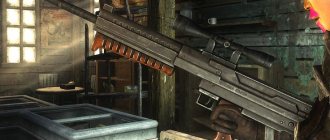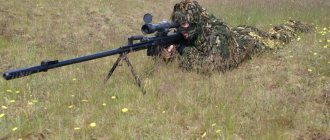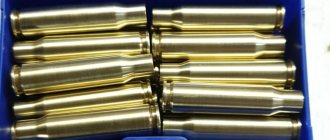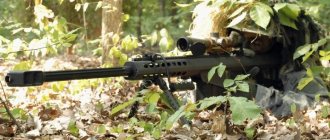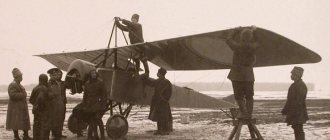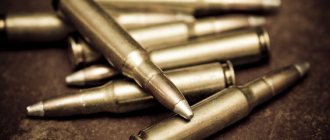Automatic Type 63 (China)
Automatic Type 63
Caliber
: 7.62×39 mm
Automatic type
: gas engine, locking by turning the bolt
Length
: 1029 mm
Barrel length
: 521 mm
Weight without cartridges
: 3.49 kg
Rate of fire
: 750 rounds per minute
Magazine
: 20 or 30 rounds
The Type 63 assault rifle (in some sources this model is also called Type 68, in others the designation Type 63 refers to models with a milled receiver, and Type 68 to models with a stamped receiver) was adopted by the PLA in the early 1960s and is interesting because , which is a mixture of several other designs and original solutions. Outwardly, it strongly resembles the Soviet-designed Simonov SKS carbine, produced in China under the designation Type 56, at the same time it had a locking scheme inherited from the Kalashnikov assault rifle (also produced in China under license and also under the designation Type 56). In addition, the Type 63 assault rifle had a number of individual features. According to available data, over a million Type 63 assault rifles were produced in the PRC, some of which were supplied to various leftist and “anti-imperialist” regimes and movements in Asia and Africa. A variant of the Type 63 assault rifle was produced under license in Bangladesh. In the eighties, the PLA gradually began to replace Type 63 assault rifles with more modern Type 81 assault rifles.
The general layout and solid wooden stock of the Type 63 assault rifle were borrowed from the SKS carbine, and the general outline of the receiver was taken from it. The receiver on early production machines is milled from steel, on later ones it is stamped from steel sheet. The locking unit with a rotary lock resembles that of a Kalashnikov assault rifle. The gas release mechanism - with a short working stroke of the gas piston located above the barrel, is similar to a similar unit in the Soviet Simonov SKS carbine, and has a two-position gas regulator of the original design. The design also includes a bolt stop mechanism inherited from the SKS, which leaves the bolt in the open position after all the cartridges in the magazine have been used up. In the front part of the bolt frame there are guides for clips, allowing you to equip an empty magazine with the bolt open, without separating it from the weapon (also similar to the SKS carbine). Fire modes - single shots and automatic fire, fire mode selector/safety is located in front of the trigger guard, on the right. Food is supplied from detachable double-row magazines for 20 or 30 rounds, structurally similar to AK magazines, however, not identical to them. The Type 63 assault rifle was equipped with an integral, folding, faceted, needle-shaped bayonet and a carrying strap.
Type 63/Type 68 assault rifle
Home | Weapons | Assault rifles | China | Type 63 / Type 68
Automatic carbine Type 63 / Type 68 (PRC)
An automatic carbine (automatic) for the People's Liberation Army of China (PLA) began to be designed in 1959. In 1963, to replace the semi-automatic Type 56 carbine, the Type 63 carbine was created, which has the ability to fire in bursts. In 1968, the automatic carbine was adopted by the PLA, and therefore the Type 63 is designated by Western experts as the Type 68.
The Type 63 / Type 68 automatic carbine is interesting because it is a mixture of several other designs and original solutions. Externally, the Type 63 strongly resembles the Soviet-designed Simonov SKS carbine, produced in China under the designation Type 56, but at the same time has a locking scheme inherited from the AK, also produced in China under license under the designation Type 56. At the same time, the Type 63 automatic carbine had and a number of individual characteristics.
The general layout and solid wooden stock of the Type 63 automatic carbine are borrowed from the SKS carbine. The general outline of the receiver is also borrowed from the SKS carbine. The receiver on early models is milled from steel, on later ones it is stamped from sheet steel. The locking unit with a rotary lock resembles that of an AK.
The gas release mechanism - with a short working stroke of the gas piston located above the barrel, is similar to a similar unit in the Soviet Simonov SKS carbine, and has a two-position gas regulator of the original design. The design also includes a bolt stop mechanism inherited from the SKS, which leaves the bolt in the open position after all the cartridges in the magazine have been used up. In the front part of the bolt frame there are guides for clips, allowing you to equip an empty magazine with the bolt open, without separating it from the weapon (also similar to the SKS carbine).
Fire modes: single shots and automatic fire. Fire mode switch - the safety is located in front of the trigger guard, on the right. The Type 63 is fed from detachable double-stack magazines with a capacity of 20 or 30 rounds, structurally similar to AK magazines, but not identical to them. The Type 63 was equipped with an integral folding bayonet and a carrying strap. Due to poor performance and the availability of more modern weapons, the Type 63/Type 68 was withdrawn from Chinese service in 1978.
In addition to China, the Type 63 automatic carbine was in service with Albania, Afghanistan, Cambodia, and Vietnam. Also, a version of the Type 63 assault rifle was produced under license in Bangladesh. Over a million Type 63s were produced in the PRC, some of which were supplied to various leftist and “anti-imperialist” regimes and movements in Asia and Africa.
Technical characteristics of the Type 63 automatic carbine
Caliber: 7.62×39 Length: 1033 mm Barrel length: 531 mm Weight: 3.8 kg. Magazine capacity: 20 or 30 rounds Muzzle velocity: 735 m/s Effective firing range: 500 m Rate of fire: 680 - 725 rounds/min
Assault rifles
- Austria
- Brazil
- Czech
- South Korea
- South Africa
- France
- USA
- Singapore
- Spain
- Russia/USSR
- Australia
- Finland
- Germany
- Türkiye
- Switzerland
- Denmark
- Japan
- Israel
- Sweden
- Indonesia
- Belgium
- Poland
- Ukraine
- Italy
- Croatia
- Iran
- Dominican Republic
- Mexico
- Serbia
- Argentina
- China
- Canada
- Taiwan
- Great Britain
Assault rifles of the world | Page 1 | Online library
Maxim R. Popenker
ASSAULT RIFLES OF THE WORLD
INTRODUCTION
There is often confusion about what the difference is between a machine gun and an assault rifle. And the whole difference is in the languages. It’s just that what in Russian is usually called “Avtomat” (in relation to weapons) in English is called “Assault rifle”, i.e. “Assault rifle”. In the future, I will use the more familiar domestic term “Avtomat”, introduced in the 20s of the twentieth century by the Russian gunsmith Frolov to designate “machine guns” of the Fedorov system.
The assault rifle is the main offensive weapon of modern infantry. Modern assault rifles usually have a caliber from 5.45 to 7.62 mm, magazine capacity from 20 to 30 or more rounds, fire modes: fully automatic (bursts) and single shots, and some models also have a cut-off (i.e. bursts) 2 or 3 shots). The effective firing range is on average up to 600 m, the effective practical rate of fire is up to 400 rounds/min in bursts. Many machine guns (including those shown here) are the “progenitors” or components of entire families of automatic weapons (from short “carbines” to light machine guns - the Austrian AUG or the AK/RPK family is a good example). Almost all machine guns can be equipped with a bayonet, night, optical or collimator sight, and some can also be equipped with an under-barrel 30–40 mm grenade launcher or an attachment for throwing rifle grenades (rifle grenades are placed on the barrel and fired with a blank cartridge).
Modern trends for assault rifles are the widespread use of composite plastics and light alloys, the installation of built-in optical or collimator sights with magnification from 1× to 4–6×, the transition to the “bullpup” design (mechanics in the butt).
According to the classification adopted in the USSR/Russia, assault rifles can be considered the second generation of automatic rifles, that is, individual automatic weapons (intended for firing in bursts). The distinction between generations is made by the cartridge used in a given weapon. If a weapon uses a powerful rifle-type cartridge (for example, 7.62 mm NATO, 7.5 mm Swiss), it is classified as first generation. Classic examples of first-generation automatic rifles are the American M-14 and AR-10, the Belgian FN FAL, and the German G3. If a weapon uses so-called “intermediate” cartridges (7.62×39, 5.45×39, 5.56 mm NATO (5.56×45)), such a weapon is classified as the second generation and is called the “automatic machine” itself or “ assault rifle". The main advantages of weapons chambered for the intermediate cartridge are: lower weight of portable ammunition, lower recoil energy of the weapon (and, as a result, a reduction in the weight of the weapon and easier control of automatic fire).
The first machine gun was created in Russia during the First World War. The Germans took the next step, creating by 1944 a real StG44 assault rifle chambered for their own intermediate cartridge 7.92x33 mm, but the first truly widespread (and one of the most famous in the world) was the Soviet Kalashnikov AK assault rifle (called AK-47 in the West) .
The next step was taken in the United States by adopting the M-16 rifle in 1963, chambered in a specially created small-caliber and low-pulse cartridge .223 Remington or M193 5.56×45 mm (created by Sierra Bullets based on the .222 Remington hunting cartridge). In the 1980s, a modification of this cartridge, developed in Belgium under the designation SS109 (with a heavier bullet), was adopted as the standard 5.56 mm NATO ammunition. Following the USA, the USSR is adopting the M73 5.45x39 mm low-pulse cartridge and the AK-74 and RPK-74 weapon systems for it.
It must be said that the debate about whether it was worth adopting a small-caliber cartridge into service in the USSR (and this was clearly done “after” “potential enemies”) does not subside to this day. The most widely used 5.45 mm caliber cartridge, 5N7, has a low-stability bullet with little stopping power and penetrating power, and improved 5N10 cartridges with a steel carbide core, apparently, have not been widely supplied to the troops. It is not surprising that in local conflicts the good old AKM and RPK chambered for the time-tested and quite effective 7.62 mm (7.62×39) cartridge are often used. To confirm this, just look at the reports on the fighting in Chechnya. And M. T. Kalashnikov himself said that by the time the 5.45 mm complex (cartridge/automatic/light machine gun) was adopted into service, the potential of the 7.62x39 cartridge had not yet been fully revealed. In addition, it seems to me that in conditions of battle in populated areas, when the battle distances are small and the first place comes to the out-of-barrier, lethal and stopping effect of the bullet (the mass of carried ammunition becomes less critical, because your rear is nearby), they could best demonstrate yourself with 9 mm cartridges (9×39 mm SP-6, PAB-9). They are capable of hitting targets wearing body armor and behind light cover at a distance of urban combat (100–400 m) and have a high stopping effect (important in collisions at short distances - in ruins, during “cleansing” of populated areas). I think that complexes like “Groza” for 9 mm ammunition could demonstrate their effectiveness.
AUSTRALIA
AICW Combination Assault Rifle
Advanced Infantry Combat Weapon
one of the first concept drawings of the AICW system (2001)
drawing of the AICW system (2003)
AICW VX3 prototype in testing (second half of 2005)
| Caliber: | 5.56×45mm NATO + 40mm |
| Automation type: | gas vent, locking by rotating the bolt + multi-charge grenade launcher according to the Metal Storm scheme |
| Length: | 738 mm |
| Barrel length: | n/a |
| Weight: | 6.8 kg without cartridges and grenades, without sight; 7.85 kg with 30 rounds, 3 grenades, without sight; 9.9 kg with ammunition and electronic sight |
| Rate of fire: | 650 rounds per minute (automatic barrel) |
| Shop: | 30 rounds of 5.56 mm + 3 grenades in the barrel of the Metal Storm grenade launcher |
Despite its apparent detachment from the world's weapons development centers, Australia is nevertheless conducting its own development of “21st century infantry weapons.” Based on the concept of the American system, the Australians began developing their own, no less ambitious, and partly more original system with the similar name AICW (Advanced Infantry Combat Weapon - advanced infantry combat weapon). The development of the system is led by the Australian Department of Defense, and the main contractors are the Australian companies ADI Limited (responsible for the shooting part of the complex and system integration), Tenix Defense (development of the electronic sighting system) and Metal Storm (development of grenade launcher modules).
Perhaps of greatest interest is the Metal Storm multi-charge grenade launcher, which makes it possible to extremely simplify the design of the grenade launcher module, reducing it to a replaceable magazine barrel and a small electronic circuit. In addition, due to the fact that the barrel of a grenade launcher is also a magazine for it, by simply replacing the barrel it is possible not only to change the type of ammunition, but also the caliber - for example, a shooter can carry a barrel with 20 mm high-speed and long-range HE grenades, as well as barrel with low-velocity 40 mm grenades with a non-lethal warhead (smoke or tear gas, etc.). If necessary, a new barrel magazine is simply installed on the weapon, while its electronic control circuit automatically connects to the sighting module and transmits to it data on the type of ammunition used, which allows the sighting system to be properly adapted for accurate fire without the participation of the shooter. The shooting part of the AICW complex is based on the standard Australian rifle F88A2, an Austrian-designed assault rifle manufactured in Australia under license. At the same time, by maintaining a full 50 cm barrel, the high efficiency of the “kinetic” small arms component of the weapon is maintained, which, in combination with an electronic sight, will potentially make it possible to hit targets with conventional bullets with greater efficiency than is possible for the “short-barreled” kinetic component of the American system.
Type 63, Light amphibious tank
Light tank “Type 63”.
At the end of the 1950s, several batches of PT-76 light amphibious tanks were delivered to China from the Soviet Union. Based on the PT-76 tank, a version was developed, called Type 60. During subsequent work to improve this tank, a modification was created, called Type 63. The design uses assembly units of the PT-76 and the Type 77 armored personnel carrier (the Chinese version of the Soviet armored personnel carrier -50pcs).
The tank hull is welded from steel armor plates. Divided into 3 compartments - the fighting compartment in the middle, the engine and transmission compartment in the stern and the control compartment in front. The driver's seat is shifted to the left side. To monitor the road, he uses three prism devices, one of which can be replaced with a driver's NVG. The remaining crew members are located in the turret: the tank commander and gunner are on the left, and the loader is on the right of the gun. A characteristic feature of the turret is a dome-shaped fan located on the roof behind the tank commander's hatch.
The main armament of the tank is an 85-mm rifled gun. It can fire armor-piercing, armor-piercing high-explosive, cumulative, high-explosive and smoke ammunition. The total ammunition load of the gun is 47 rounds. Coupled with the cannon is a 7.62-mm machine gun mounted to the right of it with 1,000 rounds of ammunition. The aiming and observation devices are optical, which do not have significant differences from the devices of the main Type 59 tank. The turret guidance drives are manual and electric, the gun lifting mechanism is mechanical. Pointing angles in the vertical plane range from -5 to +18 degrees. Some vehicles were equipped with a Chinese-made laser rangefinder, similar to that used on the main Type 59 tank. A 12.7-mm anti-aircraft machine gun with 500 rounds of ammunition was placed on the pivot of the base of the loader's hatch. The tank has bulletproof armor, typical for fully amphibious tanks, i.e. floating at the expense of their own displacement without any additional means or machines. The thickness of the armored parts of the hull ranges from 10 (sides, roof, stern, bottom) to 14 (lower frontal part) millimeters. The upper frontal part, which has a thickness of 11 mm and an angle of inclination of 80 degrees to the vertical, is additionally protected by a wave-reflective shield that is placed on it when moving on land.
The turret is welded from cast and rolled armor parts. The tank uses a fire-fighting equipment system similar to the fire protection system of the PT-76 tank. The tank reaches a maximum speed of 64 km/h when driving on the highway, and 12 km/h when afloat. The fuel range is 370 km with a fuel tank capacity of 545 liters. Additional barrels can be installed at the stern of the hull. The MTO is equipped with a 12-cylinder liquid-cooled diesel engine with a power of 294 kW (400 hp). The mechanical transmission provides 5 forward gears and 1 reverse gear. The transmission provides power take-off for jet water-jet propulsion. The chassis is six-roller, the road wheels are similar to the rollers of the PT-76 tank, and the suspension is individual torsion bar. The chassis layout is traditional, with rear driving and front steering wheels. The tank was used during the fighting with Vietnam.
Combat weight - 18.7 tons Crew - 4 people. Tower roof height – 2520 mm Gun – 85 mm, rifled Ammunition – 47 rounds Ammunition types – Br, BFS, BKS, OFS, DS Range finder – no (laser) Weapon stabilizer – no Ballistic computer – no Gun loading – manually Machine guns – one 12.7 mm; one 7.62 mm Maximum speed - 64 km/h Cruising range on the highway - 370 km Engine - V-shaped 12-cylinder diesel Armor protection - bulletproof Engine power - 294 kW Transmission - simple mechanical Track - with open metal hinges Suspension - individual torsion bar Depth of surmountable water obstacle – floating tank
Best loadout for Type 63 Warzone SMG
Try these best Type 63 attachments in CoD Warzone for close combat:
- Muzzle - GRU Silencer
- Barrel - 16.4 inches, titanium
- Optics – Millstop Reflex Sight
- Supply – KGB Notebook
- Back Handle - Snake Grip
The attachments used are aimed at increasing the efficiency and overall mobility of the weapon. The Type 63 TTK is extremely fast and gets even better when you get headshots.
The titanium barrel significantly improves the rate of fire. The snake grip allows for quick aiming down (ADS) with a slight reduction in sprint to fire time. In addition, the KGB Pad compensates for the shortcomings of the rear grip and gives the weapon additional mobility.
Related: All Artifact Abilities in Call of Duty: Vanguard Zombies
This Type 63 build can easily replace any other SMG. It should be noted that this weapon is suitable for players who can fire quickly.
Construction[edit]
The locking mechanism was borrowed from the Type 56 assault rifle (licensed version). The receiver is milled (for early-release weapons) or stamped (for late-release weapons). Instead of an integral SKS magazine, sector magazines with 20 or 30 rounds are used, but the ability to equip an empty magazine from clips without separating it from the weapon remains. It is now possible to fire in bursts, for which there is a fire mode switch from semi-automatic to automatic. In addition, the rifle is equipped with a folding bayonet. Removed from service by the PLA in 1978 due to a planned replacement.
The effective firing range is within 300-400 meters in single-shot mode.



